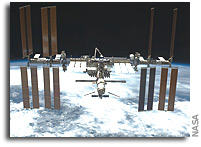NASA International Space Station Lead Increment Scientist’s Weekly Highlights: Week Ending May 16, 2011

(Highlights: Week Ending May 16, 2011) — On May 19, The Alpha Magnetic Spectrometer – 02, or AMS-02, was installed, activated, checked out, and started into nominal operations. On the first day of operation, the data collected from over 300,000 data channels showed over 50 million cosmic ray hits. The AMS-02 uses the unique environment of space to advance knowledge of the universe and lead to the understanding of the universe’s origin by searching for antimatter, dark matter and measuring cosmic rays.
Space station astronaut Cady Coleman set up the Commercial Generic Bioprocessing Apparatus Science Insert – 05, or CSI-05: Spiders, Fruit Flies and Directional Plant Growth. Before departing the space station, Coleman named both of the spiders: Esmerelda and Gladys. They are looking healthy, and have both spun webs. The fruit flies also are healthy and a good colony appears with flies, pupae and larvae. Results from CSI-05 may help scientists more clearly understand how different organisms are affected by the microgravity environment. CSI-05 also provides a unique educational opportunity to encourage and inspire students to pursue careers in the scientific and technical fields by participating in near real-time research activities aboard the station.
Two crew members performed sessions with Validation of Procedures for Monitoring Crew Member Immune Function, or Integrated Immune. The experiment assesses the clinical risks resulting from the adverse effects of spaceflight on the human immune system and will validate a flight-compatible immune monitoring strategy. Changes in the immune system are monitored by collecting and analyzing blood and saliva samples from crew members during flight and blood, urine, and saliva samples before and after spaceflight.
For the Japan Aerospace Exploration Agency’s Mycological Evaluation of Crew Exposure to ISS Ambient Air, or Myco, two crew members performed body sample collection sessions and put the samples in the MELFI. Myco evaluates the risk of microorganisms’ via inhalation and adhesion to the skin to determine which fungi act as allergens on the space station.
Vic Cooley, Lead Increment Scientist Expedition 27/28








